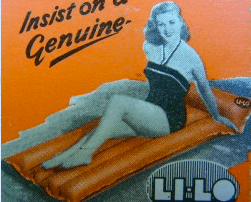 My first memories of being in surf are as a child in the late 1950s, floundering around at Marion Bay (Tasmania) on what we called a Li-Lo. It was longer than the ‘surf-o-planes’ (surf mats) that had been invented in Australia in the 1930s, more like a floating mattress than a surfing device. My only recollection of it is being spun sideways and thrown off as the whitewater broke over me. I have no pictures, but recall it being blue and white striped on the top and plain blue underneath.
My first memories of being in surf are as a child in the late 1950s, floundering around at Marion Bay (Tasmania) on what we called a Li-Lo. It was longer than the ‘surf-o-planes’ (surf mats) that had been invented in Australia in the 1930s, more like a floating mattress than a surfing device. My only recollection of it is being spun sideways and thrown off as the whitewater broke over me. I have no pictures, but recall it being blue and white striped on the top and plain blue underneath.
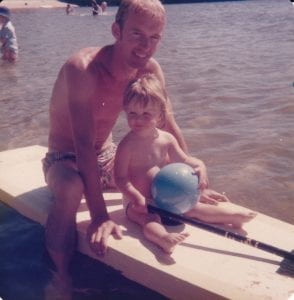 A few years later my parents bought me a kit for the construction of a wooden paddle board. Not being a dab hand, my father did most of the serious work putting the frame together and attaching the marine ply sheets for the deck and hull: my main task was the less taxing paint job. This time I have a pic, though it is from nearly two decades later on a similar board at Howrah Beach where we lived at the time. My efforts at surfing on it were again pretty dismal, seemingly spending more time below the surface than above it.
A few years later my parents bought me a kit for the construction of a wooden paddle board. Not being a dab hand, my father did most of the serious work putting the frame together and attaching the marine ply sheets for the deck and hull: my main task was the less taxing paint job. This time I have a pic, though it is from nearly two decades later on a similar board at Howrah Beach where we lived at the time. My efforts at surfing on it were again pretty dismal, seemingly spending more time below the surface than above it.
My surfing became serious at about the age of 16, when I bought a second-hand Ron surfboard for $60. It was 9′ 6″ long and heavy, with a wooden stringer, single fin and of course, no leg rope. My friends had similar boards (you know who you are: John Tomlin, John Nichols, Andrew Tompson and Charlie Woollard), and as far as skill levels are concerned, I was at the lower end of the spectrum. This lack of ability was fuelled by my mediocre swimming strength, making me nervous of wiping out and struggling after the board in heavy surf.
I should probably add that Andrew was the surfing exception – not sure why he chose a different path, but he was one of the faithful few in Australia with a penchant for kneeboards, including the purchase of a George Greenough ‘Spoon’.
Boards began to get shorter, and surfboard constructors popped up everywhere, even in Tasmania. The two Johns, Tomlin and Nichols, had the nerve, wherewithall and skills to chop up their longboards and experiment with new shapes. I took the more conservative route, selling the Ron and buying (again, second-hand, from John Davis) a lovely 7’6″ board by Horton and Steven (number 38, unless I’m mistaken).
I still lacked the skills of my friends, but recall happy days at Clifton Beach, one of the two main local beaches that became the principal surfing spots (the other being Park Beach). Wetsuits were rudimentary at best, and board shorts expensive – my girlfriend Marilyn made me an excellent pair of blue and white Hawaiian print boardies. A vivid memory is an Easter trip to Cloudy Bay on Bruny Island, having the place largely to ourselves for about four days.
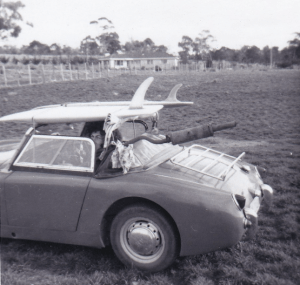 I also recall a surf trip up the East Coast with John Tomlin in my less-than-ideal soft-top car. I still had H&S 38 and he took his home-made special. As you can see, we attached the boards to the windscreen and the hood frame. We spent a night or two on the road, catching nothing as I recall, the only excitement being the detachment of the exhaust system of the car as we bounced across a field near Swansea. It made for an exceptionally noisy drive home.
I also recall a surf trip up the East Coast with John Tomlin in my less-than-ideal soft-top car. I still had H&S 38 and he took his home-made special. As you can see, we attached the boards to the windscreen and the hood frame. We spent a night or two on the road, catching nothing as I recall, the only excitement being the detachment of the exhaust system of the car as we bounced across a field near Swansea. It made for an exceptionally noisy drive home.
Life then intervened and curtailed any further surfing adventures for some decades. Meanwhile, though, I learned to swim more confidently, and when we returned to Australia in 2005 Marilyn and I continued our interest, including participation in ocean swim racing for a few years. These are run regularly by surf clubs each summer, and we tried them at a number of popular spots around Victoria (Portsea, Point Lonsdale, Dromana, the Big Bay swim, etc.). I mostly enjoyed them, although to my chagrin I never managed to beat Marilyn, who’d always been a much more stylish and efficient (i.e. faster) swimmer than me.
With my new-found confidence in ocean swimming, I decided to return to surfing. What minimal skills I’d had when younger had clearly deserted me, and I didn’t fire on my newly-purchased 7’8″ tri-fin board. Somewhat disenchanted, I happened to be at Point Leo when I spied someone out on a waveski. When he came in I chatted to him, and was inspired to give it a go.
A few weeks later I picked up a second hand 2.6 metre WaveMaster Stabilizer Comp. I took it slowly, first just paddling out into Port Phillip Bay to build my skills before venturing into the surf. I went back to Point Leo to try it out properly, and that’s the place I’ve now been going to for over a decade to experience the joys of surfing on a waveski. I’ve owned four of the craft (all by WaveMaster), one being the high performance model which I found too skittish and difficult to maintain balance with its high centre of gravity. I’m now happily settled with a 2.4 metre Stabilizer Comp, though am considering investing in a custom made model (lighter – it can feel heavy carrying it back up the steps after an hour and half in the water!).
There’s a particular spot there (Crunchy Point – it’s a rocky bottom) which is perfect – no shore break to battle, and on a good day a long, glorious ride of 100-200 metres (as long as you get through the fat section in the middle). It’s not usually too crowded (especially in winter), there’s a mix of ages, gender, boards and people are mostly pretty relaxed and friendly. Waveskis are not always that popular among surfers, but the SUPs (which are usually there) are even less liked, as they can catch a wave further out than any of the rest of us.
In recent years I’ve been visiting Queensland, more specifically Alexandra Headland on the Sunshine Coast, and have needed something else to surf on. It’s not the kind of place to take a waveski, as it’s a beach break with a reasonably heavy shore break. I’ve experimented with a surfboard and kneeboard, but eventually settled on a bodyboard (boogie board?) as my board of choice. And why? Because I’ve simply found it to be so much fun. The water’s warm, and it’s pure pleasure to float around out the back then chase a wave though the pack of board surfers … even better when there’s a quiet spot with not many out. And you can go out and come in smiling even when the conditions are a bit off – gnarly, windy, whatever.
But it doesn’t end there; the circle requires completion. A year or so back I was at Ocean Grove with my neighbour Andrew (he has a strategically placed van there) and we were perusing the stock at an Op Shop when I spied an author-signed hardback version of the book Stoked, by Bob McTavish. It was a steal at $5, and turned out to be a ripping read. He writes wittily and engagingly and comes across well, my only misgivings being his decades long association with a certain fringe religious cult for which I have a particularly and justifiably strong loathing (hint: they knock uninvited on your door from time to time).
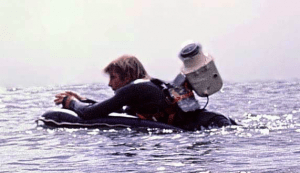 That aside, some of the best bits of the book concern the afore-mentioned George Greenough. One of the great pioneers of surfing and surf photography, something I hadn’t fully apprehended until I read the McTavish account was that most of George’s best tube footage (e.g. in Crystal Voyager and The Innermost Limits of Pure Fun) was not filmed from the Spoon, but from a surf mat! To fully appreciate this feat, be reminded that that this was abut 50 years ago, and George was attached to about 27 pounds of camera equipment (self-designed and built).
That aside, some of the best bits of the book concern the afore-mentioned George Greenough. One of the great pioneers of surfing and surf photography, something I hadn’t fully apprehended until I read the McTavish account was that most of George’s best tube footage (e.g. in Crystal Voyager and The Innermost Limits of Pure Fun) was not filmed from the Spoon, but from a surf mat! To fully appreciate this feat, be reminded that that this was abut 50 years ago, and George was attached to about 27 pounds of camera equipment (self-designed and built).
Consequently, while in Covid lockdown, time was spent investigating surf mats, discovering that there’s an ongoing interest being sustained by small groups of enthusiastic designers and practitioners. Surf mat design has advanced significantly in recent decades, especially with respect to materials, so that now a serious mat surfer will part with hundreds of dollars for a desired model. Armed with my newfound knowledge and emerging enthusiasm (i.e. from watching many YouTube videos on surf mats), I put in a special request (demand) to my children for a birthday/Xmas present of a Krypt MT5.
If you’re becoming tempted, just watch the following to be completely convinced:
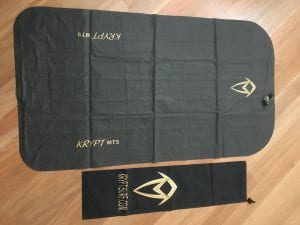 I’ve now had my mat for a couple of months and have tried it both in the ocean and at Melbourne’s UrbnSurf (the artificial surf centre). As I’d been warned, it takes a while to get the hang of it, but its potential is readily apparent even when you’re being thrown around in messy shore break at Ocean Grove. With that behind me, I tackled UrbnSurf (Intermediate Left) and was happy with how it went. It’s a bit weird paddling out with the others, all of whom are of course on standard boards, and me on my floppy mat (strangely, surf mats perform better when only partially inflated). And the first takeoff can be a tad nerve-racking, as you don’t want to fail and end up in the way of the next person in line.
I’ve now had my mat for a couple of months and have tried it both in the ocean and at Melbourne’s UrbnSurf (the artificial surf centre). As I’d been warned, it takes a while to get the hang of it, but its potential is readily apparent even when you’re being thrown around in messy shore break at Ocean Grove. With that behind me, I tackled UrbnSurf (Intermediate Left) and was happy with how it went. It’s a bit weird paddling out with the others, all of whom are of course on standard boards, and me on my floppy mat (strangely, surf mats perform better when only partially inflated). And the first takeoff can be a tad nerve-racking, as you don’t want to fail and end up in the way of the next person in line.
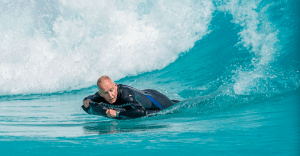 Mercifully, I caught nearly all my waves, and made some progress in skill-building. And overall it seems to be better on the mat than a bodyboard (have tried both at UrbnSurf). It also seemed a good sign that some of my fellow participants chatted and asked about the mat. Basically it was fun, and I left the water smiling.
Mercifully, I caught nearly all my waves, and made some progress in skill-building. And overall it seems to be better on the mat than a bodyboard (have tried both at UrbnSurf). It also seemed a good sign that some of my fellow participants chatted and asked about the mat. Basically it was fun, and I left the water smiling.
So, there it is – in a matter of some six decades in the surf, I’ve come full circle: mat, paddle board, longboard, short(er)board, waveski, bodyboard and mat.
Started on a mat, finishing on a mat.
Thanks: to Linda Longano for the pics at Point Leo/Crunchy Point.
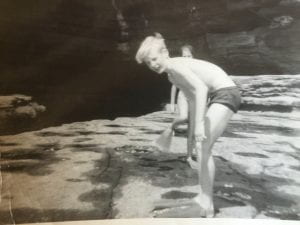 Postscript: After viewing the ‘Dance of the Mat’ video, I took Justin’s advice and ordered a pair of Duck Feet fins. In doing so, I observed that the manufacturer is Voit, and when the package arrived, noted the firm has been going for 75 years. This reminded me that my first pair of flippers (pale green, with a side buckle) were Voit! I even have a pic of me sporting them at the Blowhole at Eaglehawk Neck in Tasmania back in the early 1960s. Unbeknown to my parents (it was deemed too dangerous and out of bounds), I’d gone there with a couple of friends (Anne and Ian, children of one of Tasmania’s pioneer surfers, John Hollingsworth) and swam through the blowhole, only to be caught by my mother on the other side. She was not happy.
Postscript: After viewing the ‘Dance of the Mat’ video, I took Justin’s advice and ordered a pair of Duck Feet fins. In doing so, I observed that the manufacturer is Voit, and when the package arrived, noted the firm has been going for 75 years. This reminded me that my first pair of flippers (pale green, with a side buckle) were Voit! I even have a pic of me sporting them at the Blowhole at Eaglehawk Neck in Tasmania back in the early 1960s. Unbeknown to my parents (it was deemed too dangerous and out of bounds), I’d gone there with a couple of friends (Anne and Ian, children of one of Tasmania’s pioneer surfers, John Hollingsworth) and swam through the blowhole, only to be caught by my mother on the other side. She was not happy.

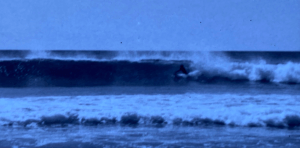
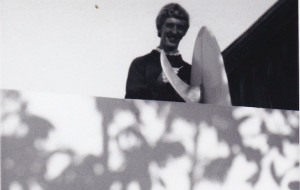
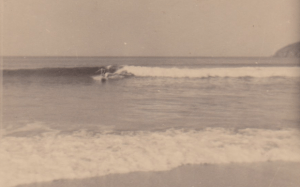
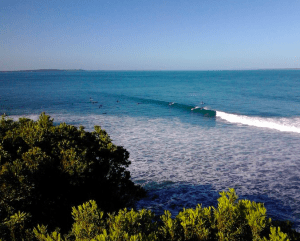

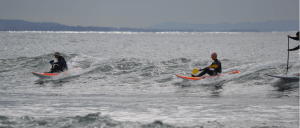

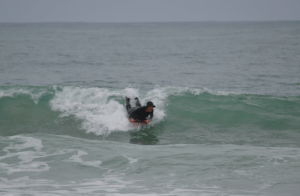
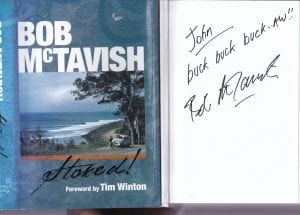
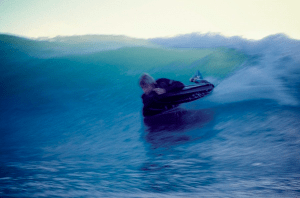
Hello David
I loved reading this post particularly as I was at a 50 year Friends’ event yesterday and sat with Brian Correy and Andrew Thompson. We even had our photo taken with your sister as your representative!
The other interesting thing for me is that I am not sure why I have missed put on your surfing interest – I married Leigh Steven and he continued to make surfboards during that time. You talk of two of his heroes – George Greenough and Bob McTavish. Amazing. Although we sre no longer married we remain friends and he lives and restores old boards in Torquay. My younger son, Joel, had followed in the surfing industry and is a designer for Rip Curl. He has travelled the world with his career and surfing and lived in France when working with Quiksilver. He now lives in Jan Juc.
Anyway such a coincidence to read your blog – I really enjoyed it and look forward to reading more.
Kind regards
Mary Woolnough